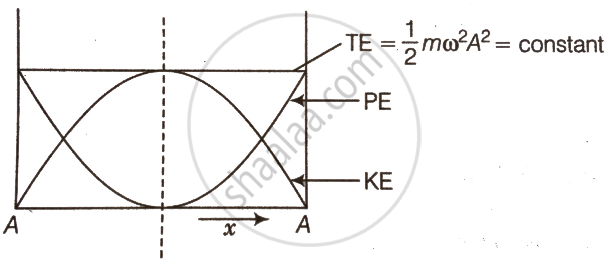Advertisements
Advertisements
प्रश्न
Draw a graph to show the variation of P.E., K.E. and total energy of a simple harmonic oscillator with displacement.
उत्तर
The potential energy (PE) of a simple harmonic oscillator is = `1/2 kx^2`
= `1/2 mω^2x^2` .....(i)
Where, k = force constant = `mω^2`
When PE is plotted against displacement x, we will obtain a parabola.
When x = 0, PE = 0
When x = ± A, PE = maximum = `1/2 mω^2A^2`
KE of a simple harmonic oscillator = `1/2 mv^2` .....`[∵ v = ωsqrt(A^2 - x^2)]`
= `1/2 m[ωsqrt(A^2 - x^2)]^2`
= `1/2 mω^2(A^2 - x^2)` ......(ii)
This is also a parabola if plotting KE against displacement x.
i.e., KE = 0 at x = ± A
And KE = `1/2 mω^2A^2` at x = 0
Now, the total energy of the simple harmonic oscillator = PE + KE .......[Using equations (i) and (ii)]
= `1/2 mω^2x^2 + 1/2 mω^2 (A^2 - x^2)`
= `1/2 mω^2x^2 + 1/2 mω^2A^2 - 1/2 mω^2x^2`
TE = `1/2 mω^2A^2`
Which is constant and does not depend on x.
Plotting under the above guidelines KE, PE and TE versus displacement x-graph as follows

APPEARS IN
संबंधित प्रश्न
A particle is in linear simple harmonic motion between two points, A and B, 10 cm apart. Take the direction from A to B as the positive direction and give the signs of velocity, acceleration and force on the particle when it is
(a) at the end A,
(b) at the end B,
(c) at the mid-point of AB going towards A,
(d) at 2 cm away from B going towards A,
(e) at 3 cm away from A going towards B, and
(f) at 4 cm away from B going towards A.
A particle executes simple harmonic motion with an amplitude of 10 cm. At what distance from the mean position are the kinetic and potential energies equal?
The block of mass m1 shown in figure is fastened to the spring and the block of mass m2 is placed against it. (a) Find the compression of the spring in the equilibrium position. (b) The blocks are pushed a further distance (2/k) (m1 + m2)g sin θ against the spring and released. Find the position where the two blocks separate. (c) What is the common speed of blocks at the time of separation?

Find the elastic potential energy stored in each spring shown in figure, when the block is in equilibrium. Also find the time period of vertical oscillation of the block.
A rectangle plate of sides a and b is suspended from a ceiling by two parallel string of length L each in Figure . The separation between the string is d. The plate is displaced slightly in its plane keeping the strings tight. Show that it will execute simple harmonic motion. Find the time period.

When the displacement of a particle executing simple harmonic motion is half its amplitude, the ratio of its kinetic energy to potential energy is ______.
If a body is executing simple harmonic motion and its current displacements is `sqrt3/2` times the amplitude from its mean position, then the ratio between potential energy and kinetic energy is:
Displacement versus time curve for a particle executing S.H.M. is shown in figure. Identify the points marked at which (i) velocity of the oscillator is zero, (ii) speed of the oscillator is maximum.

A body of mass m is attached to one end of a massless spring which is suspended vertically from a fixed point. The mass is held in hand so that the spring is neither stretched nor compressed. Suddenly the support of the hand is removed. The lowest position attained by the mass during oscillation is 4 cm below the point, where it was held in hand.
What is the amplitude of oscillation?
A particle undergoing simple harmonic motion has time dependent displacement given by x(t) = A sin`(pit)/90`. The ratio of kinetic to the potential energy of this particle at t = 210s will be ______.
